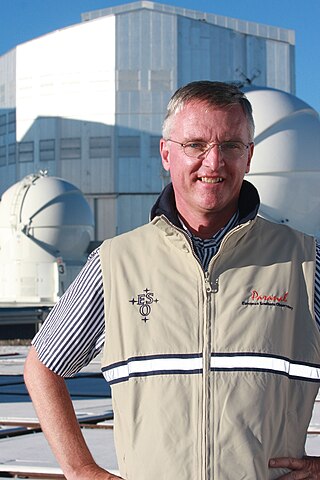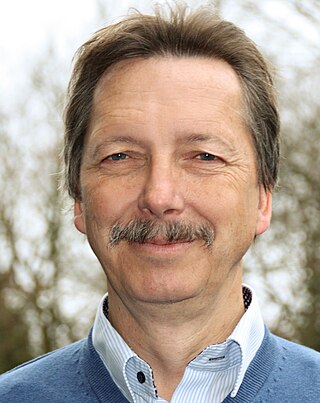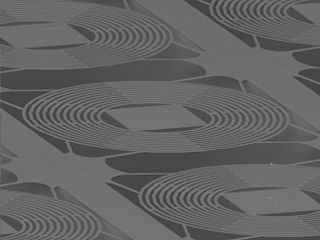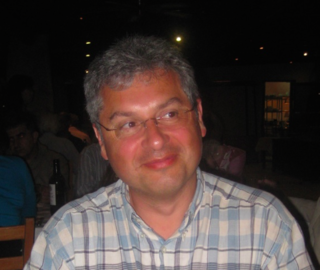Infrared astronomy is a sub-discipline of astronomy which specializes in the observation and analysis of astronomical objects using infrared (IR) radiation. The wavelength of infrared light ranges from 0.75 to 300 micrometers, and falls in between visible radiation, which ranges from 380 to 750 nanometers, and submillimeter waves.

Eleanor Margaret Burbidge, FRS (née Peachey; 12 August 1919 – 5 April 2020) was a British-American observational astronomer and astrophysicist. In the 1950s, she was one of the founders of stellar nucleosynthesis and was first author of the influential B2FH paper. During the 1960s and 1970s she worked on galaxy rotation curves and quasars, discovering the most distant astronomical object then known. In the 1980s and 1990s she helped develop and utilise the Faint Object Spectrograph on the Hubble Space Telescope. Burbidge was also well known for her work opposing discrimination against women in astronomy.

The Herschel Space Observatory was a space observatory built and operated by the European Space Agency (ESA). It was active from 2009 to 2013, and was the largest infrared telescope ever launched until the launch of the James Webb Space Telescope in 2021. Herschel carries a 3.5-metre (11.5 ft) mirror and instruments sensitive to the far infrared and submillimetre wavebands (55–672 µm). Herschel was the fourth and final cornerstone mission in the Horizon 2000 programme, following SOHO/Cluster II, XMM-Newton and Rosetta.

Submillimetre astronomy or submillimeter astronomy is the branch of observational astronomy that is conducted at submillimetre wavelengths of the electromagnetic spectrum. Astronomers place the submillimetre waveband between the far-infrared and microwave wavebands, typically taken to be between a few hundred micrometres and a millimetre. It is still common in submillimetre astronomy to quote wavelengths in 'microns', the old name for micrometre.
Tod R. Lauer is an American astronomer on the research staff of the National Optical Astronomy Observatory. He was a member of the Hubble Space Telescope Wide Field and Planetary Camera team, and is a founding member of the Nuker Team. His research interests includes observational searches for massive black holes in the centers of galaxies, the structure of elliptical galaxies, stellar populations, large-scale structure of the universe, and astronomical image processing. He was the Principal Investigator of the Destiny JDEM concept study, one of the precursors to the Nancy Grace Roman Space Telescope mission. Asteroid 3135 Lauer is named for him. He appears in an episode of the documentary series Naked Science. He joined the New Horizons Pluto team in order to apply his extensive experience with deep space imaging to the New Horizons data, yielding significantly clearer and mathematically accurate images of Pluto and Charon.

SRON Netherlands Institute for Space Research (SRON) is the Dutch expertise institute for space research. The institute develops and uses innovative technology for analysis in space, focusing on astrophysical research, Earth observation, and exoplanetary research. SRON conducts research into new and more sensitive sensors for X-rays, infrared radiation, and visible light.

Claire Ellen Max is a Professor of Astronomy and Astrophysics at the University of California, Santa Cruz (UCSC) and is affiliated with the Lick Observatory. She was the Director of the Center for Adaptive Optics at UCSC, 2007-2014. Max received the E.O. Lawrence Award in Physics.
Philip D. Nicholson is an Australian-born professor of astronomy at Cornell University in the Astronomy department specialising in Planetary Sciences. He was editor-in-chief of the journal Icarus between 1998 and 2018.

Pieter Timotheus "Tim" de Zeeuw is a Dutch astronomer specializing in the formation, structure and dynamics of galaxies. From 2007 to 2017 he was the director general of European Southern Observatory. He is married to astronomer Ewine van Dishoeck. In May 2022, Leiden University suspended him after an internal review concluded that over several years he repeatedly belittled and insulted women in public and abused his position of power as a professor by threatening to damage their scientific careers; and that in addition to intimidation and inappropriate behavior there was "a component of sexual harassment". The Max Planck Institute for Extraterrestrial Physics announced that they will no longer work with him and the European Southern Observatory banned him from accessing their premises.
George Henry Rieke, a noted American infrared astronomer, is former Deputy Director of the Steward Observatory and Regents Professor of Astronomy and Planetary Sciences at the University of Arizona in Tucson. He led the experiment design and development team for the Multiband Imaging Photometer for Spitzer (MIPS) instrument on NASA's infrared Spitzer Space Telescope, and currently chairs the science team of the Mid-Infrared Instrument for the James Webb Space Telescope.

Thomas K. Henning is a German astrophysicist. Since 2001, he is a director at the Max Planck Institute for Astronomy. Henning is an expert in the field of star and planet formation.

The SAFARI imaging spectrometer was the European image sensor of Japanese infrared telescope SPICA and is being developed under the leadership of SRON Netherlands Institute for Space Research. SAFARI is an infrared camera with about 6,000 pixels that can make real ‘photos’ of the sky in three adjacent wavelength areas. Fourier transform spectroscopy (FTS) obtains detailed spectral information, allowing astronomers to determine the chemical composition of the observed celestial sources. The Netherlands Organisation for Applied Scientific Research (TNO) is developing the mechanism of this FTS.

Alexander Godfried Gerardus Maria (Xander) Tielens is an astronomer at Leiden Observatory, Leiden University, in the Netherlands. In 2012 he received the highest distinction in Dutch science, the Spinoza Prize.

Judith Lynn Pipher was a Canadian-born American astrophysicist and observational astronomer. She was Professor Emerita of Astronomy at the University of Rochester and directed the C. E. K. Mees Observatory from 1979 to 1994. She made important contributions to the development of infrared detector arrays in space telescopes.
Patrick Thaddeus was an American professor and finished his career as the Robert Wheeler Willson Professor of Applied Astronomy Emeritus at Harvard University. He is best known for mapping carbon monoxide in the Milky Way galaxy and was responsible for the construction of the CfA 1.2 m Millimeter-Wave Telescope.

The Science Programme of the European Space Agency is a long-term programme of space science and space exploration missions. Managed by the agency's Directorate of Science, The programme funds the development, launch, and operation of missions led by European space agencies and institutions through generational campaigns. Horizon 2000, the programme's first campaign, facilitated the development of eight missions between 1985 and 1995 including four "cornerstone missions" – SOHO and Cluster II, XMM-Newton, Rosetta, and Herschel. Horizon 2000 Plus, the programme's second campaign, facilitated the development of Gaia, LISA Pathfinder, and BepiColombo between 1995 and 2005. The programme's current campaign since 2005, Cosmic Vision, has so far funded the development of ten missions including three flagship missions, JUICE, Athena, and LISA. The programme's upcoming fourth campaign, Voyage 2050, is currently being drafted. Collaboration with agencies and institutions outside of Europe occasionally occur in the Science Programme, including a collaboration with NASA on Cassini–Huygens and the CNSA on SMILE.
Luisa María Lara López is a Spanish astrophysicist. Since 2010, she has been a Spanish National Research Council (CSIC) Researcher at the Institute of Astrophysics of Andalusia in the Solar System Department.
Katherine Gudrun Isaak is a British astrophysicist and the Project Scientist for the European Space Agency Characterising Exoplanet Satellite mission (CHEOPS). She is based at European Space Research and Technology Centre.

David Elbaz is a French observational astrophysicist specialising in galaxy formation and evolution. He is Research Director at the Commissariat à l'Énergie Atomique et aux Énergies Alternatives (CEA-Saclay), where he has been a researcher in the Astrophysics Division (AIM) since 1994. There, he was in charge of directing the "Cosmology and Evolution of Galaxies" laboratory for about a decade. He is the managing editor of the journal Astronomy & Astrophysics since 2018.
Thomas Gould Phillips was a British-born physicist, who worked primarily in the United States. He was a pioneer in the field of submillimeter astronomy, who both developed new instrumentation and made ground-breaking observations. He oversaw the construction of, and was the first and longest-serving director of the Caltech Submillimeter Observatory.












